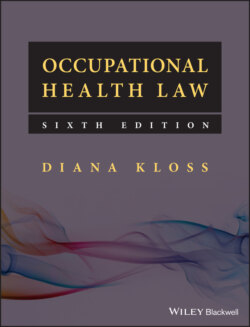Читать книгу Occupational Health Law - Diana Kloss - Страница 64
2.15 The rights of occupational health professionals
ОглавлениеThus far we have examined only those obligations which the law places on occupational health professionals. They will be relieved to read that they also have rights. The relationship with the employer will, as has been explained, rest on a contract. It is advisable to insist on a written Service Level Agreement, and employees (but not the self‐employed) can demand a written statement of pay, hours, holidays, pension and sick pay provision, periods of notice and disciplinary rules and grievance procedures, under the Employment Rights Act 1996. This statement must contain a job title, but not necessarily a job description. If the employee’s duties are not spelled out and a dispute arises, there may have to be reference to the job advertisement, what was said at the interview and custom and practice.
The Employment Rights Act 1996 gives the right to complain to an employment tribunal and to claim compensation from the employer to any employee who has been designated to carry out activities in connection with preventing or reducing risks to the health and safety of employees at work and who has been disciplined or dismissed by the employer for carrying out or proposing to carry out such activities (Chapter 7).
An interesting case was that of Woodroffe v. British Gas (1985). Miss Woodroffe was a State Registered Nurse who in 1980 entered the employment of British Gas as an OH nurse. She was given a job description which did not make any express reference to taking blood samples or giving talks on health matters to other employees. Shortly after she took up her post, a new Medical Officer was appointed. He thought that she should take blood samples and give health education talks. Miss Woodroffe explained that these tasks were classified at the time as ‘extended role’ and that she had not been trained to carry them out. The doctor offered her training which she refused. After a while, he persuaded her to take on these extra responsibilities, which she did with reluctance, thus impliedly agreeing to a variation in her contract. The Medical Officer became dissatisfied with her work, including her keeping of records. He instituted an enquiry which he presided over and which recommended her dismissal. She appealed to a higher level of management, and was represented by a member of her professional body, but the appeal was dismissed. A complaint to an industrial tribunal of unfair dismissal, and subsequent appeals to the Employment Appeal Tribunal and the Court of Appeal were also unsuccessful.
The employer’s duty to take reasonable care for the employee’s health and safety applies equally to the occupational health department. The employee is entitled to refuse to put himself in a position of imminent personal danger, as did the bank employee who declined to work in Turkey where he had previously been sentenced to death (Ottoman Bank v. Chakarian (1930)). Doctors and nurses frequently disregard their own safety to go to the assistance of their patients. One such was Dr Baker. Contractors were cleaning a deep well. They installed a petrol pump on a ledge 29 feet below ground, creating dangerous fumes in a closed space. Two workers were overcome by fumes and were unconscious down the well. Dr Baker was urged not to go down but he said: ‘There are two men down there. I must see what I can do for them.’ He died on the way to hospital. When his widow sought compensation from the contractors, they argued that the doctor had caused his own death by his foolhardiness. The widow submitted that it was reasonable for a doctor to take risks to try to save the lives of workers who had been placed in mortal danger by their employer’s lack of care. The Court of Appeal held the defendants liable. ‘Bearing in mind that danger invites rescue, the court should not be astute to accept criticism of the rescuer’s conduct from the wrong‐doer who created the danger’ (Baker v. Hopkins (1958)).
